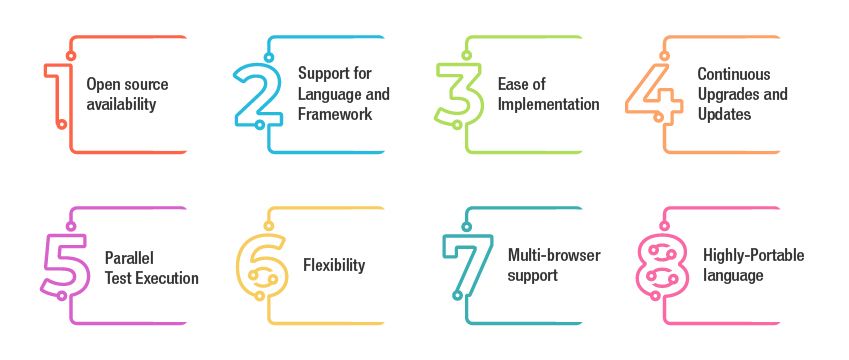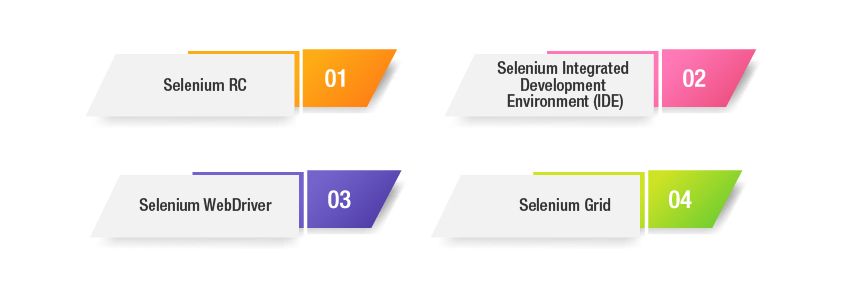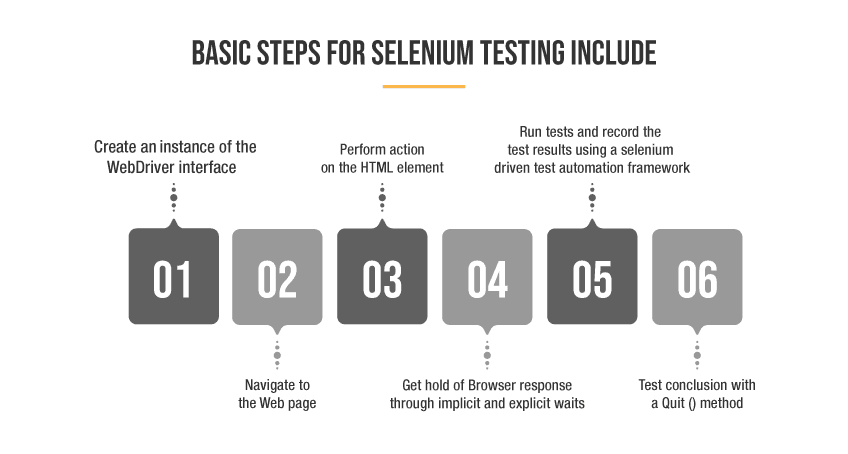
- Why Your Business Should Prefer Selenium Automation Testing?
- Key Features of Selenium Automation Testing Framework
- Significance of Selenium Automation Testing
- Best Practices of Selenium Automation Testing
- Conclusion
Software test automation is the key to success in today’s agile and DevOps processes, as the test automation tools and frameworks deliver faster and quality releases due to accurate testing that is achieved with effective test scripts execution. Test automation tools are available as both open source tools and paid tools. Selenium tool is the most widely used open-source test automation tool. It is best suited for all web applications across browsers and delivers effective results for all tests and is an easy-to-use tool with numerous effective features.
Selenium has a suite of tools that function to meet the different needs of enterprises. Generally, there are four different suites of tools, they are:
1. Selenium RC:
Selenium RC or the Selenium Remote Control was the first Selenium suite, that was known as JavaScript Executor earlier. Also, the tool is the main reason for the Selenium to become an important tool.
2. Selenium Integrated Development Environment (IDE):
It is a simple tool that comes as an add-on for Mozilla Firefox. The tool provides a good number of functionalities such as record and playback, prototype testing, and it can export the IDE test cases to any language.
3. Selenium WebDriver:
The most popular tool of Selenium Suite is WebDriver. This tool does not require any manual method like the Selenium Server. It helps to communicate directly between the browser and the code.
4. Selenium Grid:
This is the last component of selenium and is used for performing parallel or distributive testing. In addition to these functionalities, this tool allows executing test scripts on different machines across browsers and operating systems.
Why Your Business Should Prefer Selenium Automation Testing?
Key Features of Selenium Automation Testing Framework:

1.Open source availability:
Selenium is an open-source tool that is publicly accessible with no additional charges. With Selenium, it is easier to customize the code and enhance the quality of the predefined classes and functions.
2. Support for Language and Framework:
Selenium supports a good number of powerful programming languages such as Python, JavaScript, Ruby, Java, Perl, and C#. Also, to help the test script writings for selenium test automation, every supporting language has dedicated frameworks.
3. Ease of Implementation:
Selenium automation framework is easy to use the tool. The interface helps in the creation and execution of test scripts.
4. Continuous Upgrades and Updates:
Selenium is supported by many active communities. This results selenium to get updated with frequent or constant releases. The best outcome for having an active community is that the upgrades are easily accessible and understandable for any user. Selenium is the best tool when compared to other tools as it provides several features with the zero-cost requirement.
5. Parallel Test Execution:
This feature of Selenium helps to save the efforts and time of the testing teams. This tool helps to execute multiple tests in parallel which results in reduced test execution time.
6. Flexibility:
In the lifecycle of testing, test management is important to make the practice of testing efficient. With the features of regrouping and refactoring of the test cases, the usage of the Selenium tool helps the testers and developers to perform quick changes in the code. Thus, this feature reduces the complications, duplications and improves maintenance.
7. Multi-browser support:
Selenium is compatible with many browsers. It is compatible with Chrome, Opera, Firefox, Internet Explorer, Safari, and other browsers. Therefore, there is no need for the tester to rewrite the scripts for each browser separately and hence one script is suitable for all browsers.
8. Highly-Portable language:
An automation tool needs to support the different operating systems that are used by enterprises. And, when selenium is used as the automation tool, there is no hindrance as the tool supports different operating systems such as Linux, Mac, Windows, UNIX, OS, etc.
Significance of Selenium Automation Testing:
Selenium automation testing tool is available as open-source and with its ease of use, selenium continues to be the most preferred for test automation. Primarily, it is used for automating web applications as it is quick and easy to use record and playback features. Additionally, the tests can be coded in multiple programming languages and executed across various web browsers and operating systems. Further, it supports to export the scripts that are recorded to other languages such as Java, C#, Python, Ruby, JavaScript, PHP. Interestingly, there are certain best practices for test automation framework that enterprises should adopt to leverage best results with test automation.
10 Best Practices of Selenium Automation Testing Framework:
1. Understand the Application at First Place:
It is utmost important for enterprises to have a first-hand understanding of the application to be tested. If automation is required for a web application, then selenium tool can be effectively used. In addition, it is also essential to know about the underlying technologies being used. In case of desktop applications, it is essential to check if any third party controls are involved and have an evaluation of the language used to build that application.
2. Adopt Page Object Model (POM):
This is a popular test automation design pattern that helps to develop robust automation testing frameworks which are resistant to any small tweaks made in the user interface. The major benefit with this page object model is that it enhances test maintenance and reduces the duplication in code. In these models, the web pages are defined as classes and the different elements on the page become the variables and the user interactions are commonly implemented as methods. The POM frameworks are comparatively more reliable and are easy to maintain. The scripts are readable and the test scripts are reusable. It also eliminates duplicity altogether and hence POM is preferred over other models.
3. Adhere to the usage of Right Locators:
At the heart of selenium frameworks is interaction with the browser allowing to navigate, click, type, and check different objects. This all is achieved using different types of locators. These locators include Class, ID, Link Text, Xpath, CSS Selector and Tag Name. Thus, selecting the right locators is utmost important
4. Keep the Tests Independent of Each other:
Independent testing strategy wherein testing a single action or process is independent of the other. This type of testing avoids chained and brittle tests. Hence, tests should be kept as small as possible especially automated functional testing in agile and Continuous integration DevOps models on the go it is always suitable to maintain small tests.
5. Prefer to use Wait command in place of Thread. Sleep:
It is always preferred to use Wait command and it is more important to understand the usage of implicit wait and explicit wait instead of using the Sleep command. This Sleep command waits until the defined time even after the task is completed; while wait command performs the actual time to wait. Sleep command slows down the test while with the Wait, the test time is not affected.
6. Use Selenium for System Functional testing:
Automation testing framework using Selenium is best suited when the same test and the same code is used for different inputs. It is most preferred for system functional testing as well as for browser compatibility testing.
7. Prefer to Use Java Runtime Environment (JRE):
The Selenium server is programmed with Java and hence it is important to use latest version of JRE to avoid any run time errors.
8. Ensure proper communication between QA, Developers, and Operations teams:
With the agile and DevOps methodologies on the go, it is important to have proper collaboration between various teams of QA, developers and operations to achieve successful selenium testing.
9. Follow a Proper Test Naming Strategy:
It is often observed that there is a tendency for complex applications to have a number of automated test cases. If the tests are not named properly, then it may take a longer time to understand the test and it takes longer time to understand the scenarios. Therefore, to avoid such scenarios, it is important to save the test names wisely based on the scenarios. This will help to identify the test scenario by reading the name itself.
10. Hire a Dedicated Automation Engineer:
It is important for enterprises to ensure their selenium for automation testing is done by experienced selenium test automation engineers. In order to get the best practice for selenium testing, you can choose and opt an experienced automation engineer from an independent testing services provider. This helps to realize the complete benefits of test automation.
Conclusion:
Enterprises should prefer Selenium as a promising test automation tool for automating all their web applications due to its enhanced features. Leverage our customized selenium test automation frameworks to achieve faster time to market and quicker ROI along with assured quality results. Connect with our testing experts today!
Discover more
Get in Touch
Stay Updated
Subscribe for more info







